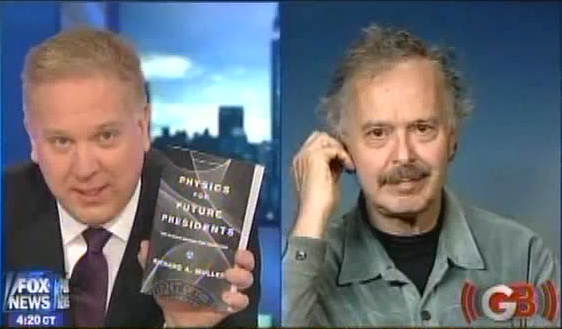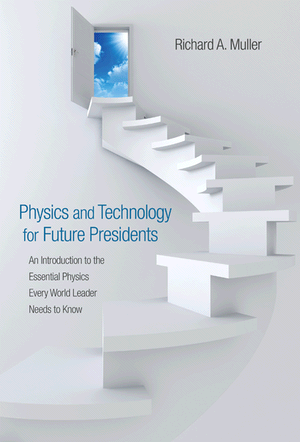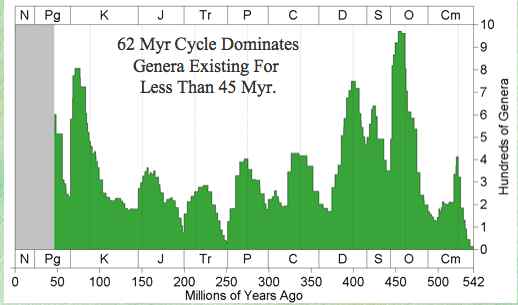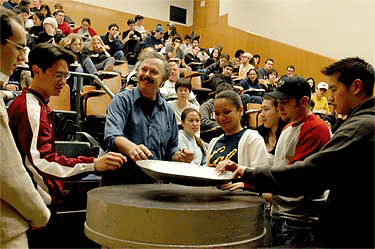Internet Archive (MP4 - 203MB)» Download this transcript (PDF)
Today I would like to talk to you about some of the research that I did during my early days at MIT.
It's a long time ago.
I got my Ph.
D in the Netherlands on nuclear physics and I came over to MIT in 1966.
I was supposed to be here only for one year.
I had a one-year postdoc position.
But I loved it so much I never left.
I changed fields.
I joined the research group of Professor Bruno Rossi here at MIT, I changed from nuclear physics to x-ray astronomy.
X-ray astronomy speaks for itself.
You're trying to do astronomy in x-rays.
You cannot see any x-rays from the ground because the earth atmosphere absorbs them completely.
So you have to go outside the atmosphere unlike optical astronomy and radio astronomy which you can do from the ground.
When I use the word x-rays I'm thinking of the kind of x-rays that your dentist would be using, medical purposes, about 1 to 50 kilo electron-volts.
And since all of you took 8.02 you should know by now what a kilo electron volt is.
Uh, optical light is 2 electron volts, where x-rays, way more energetic than optical light.
Uh, during the Second World War Wernher von Braun in Peenemunde developed under Hitler Germany destructive rockets.
They were used to destroy the Allies.
To destroy you and me.
And after the war, around 1948, the Americans used these rockets to do science.
They also got Werner von Braun over to this country and for reasons unknown to me he became a hero.
They tried to observe x-rays from the solar system.
And they found indeed that the sun emits x-rays.
The sun is very close.
So you may say well that's not a surprise.
But it's really very unusual because to create x-rays you need extremely high temperatures, which we didn't think existed on the sun.
And if you take the power that the sun puts out in x-rays, this is joules per second now, and you divide that by the power in the optical and the infrared light of the sun, this symbol stands for sun, that ratio is about 10 to the -7.
So you must conclude that the sun emits largely optical light and infrared and that the amount of x-rays is a modest byproduct.
Interesting as it is all by itself.
In 1962 several scientists here in Cambridge, Massachusetts, among them Bruno Rossi and Riccardo Giacconi and Herb Gursky, made an attempt to observe x-rays from stars outside our solar system.
The odds were strongly against them.
The detectors were not sensitive enough.
If you take the sun and you bring the sun to the nearest stars, which is a distance say of 10 light-years, then there would be no hope that you would be able to detect x-rays from an object like the sun.
In fact the detectors were too insensitive by about a factor of one billion.
They tried anyhow and they were successful.
They did indeed find to everyone's surprise and joy, they found x-rays from at least one object outside the solar system.
This object was later called SCO X-1.
SCO stands for the constellation Scorpio in the sky and X for x-rays and 1 for the first source observed in that constellation.
We now know that this object is a faint blue star.
And what is extremely special about the object SCO X-1 is that if you take the ratio x-ray power over optical power then that ratio is about 10 to the 3rd.
Compare that with the sun.
This object, we had no clue what it was in those days, primarily emit x-rays, and the optical emission is a byproduct.
Whereas with the sun it is reversed.
And so the burning question was in those days, what kind of animal is this?
It must be a totally different beast.
Something very different from our sun.
And when I came to MIT in 1966, there were six sources known outside our solar system.
And they were all discovered with rockets.
The rockets in those days could spend about five minutes above the earth atmosphere and they would quickly make a scan over the sky, five minutes, that's all they had.
And I joined the group of uh George Clark, who is still at MIT, uh he was doing x-ray astronomy from very high-flying balloons, very close to the top of the atmosphere, and the advantage of balloons was that you could observe the sky for many, many hours, if you're lucky sometimes even a day or more.
But on the other hand, since there is always a little bit of atmosphere left above you, even though there's very little, there is still some left, the x-rays are absorbed, almost all x-rays below 20 kilo electron-volts would be absorbed, and we would not be able to see them.
But of course the compensation was that we could look at the sky for many, many, many hours.
Nowadays no one is doing these balloon observations anymore.
No more rocket observations.
Everything is done of course from satellites.
So when I came to MIT, together with George Clark, I developed new x-ray detectors for these balloon observations.
Many graduate students were involved.
Many undergraduates.
It would take about two years to build a telescope.
To give you a rough idea it would take a million dollars in terms of 1966 dollars, and the weight of such a telescope would be roughly 1000 kilograms.
The balloons in those days would cost about $100,000 to get us up to these high altitudes, and we would need about $80,000 of helium, and you will see some slides of that.
We have to go to altitudes of about 140000 feet.
We had huge balloons for that.
You will see one.
They have diameters of about 600 feet.
And the material was polyethylene.
Extremely thin to make them light-weight so that they can go high.
The thickness of that polyethylene was about half of one-thousandth of an inch.
Which is thinner than the saran wrap that you have in the kitchen.
It is thinner than cigarette paper.
A very risky business to fly these balloons.
No guarantee of course that they would work.
You pay your money.
If they work that's great.
If they don't work that's just tough luck.
There is a good chance that you have a failure when you launch the balloon.
They're very fragile.
There could be damage right at the launch.
But even if they make it up in the atmosphere they have to go through the tropopause, near about a hundred thousand feet where it's very, very cold, the balloons get brittle, and then they can burst.
And that of course would be the end then of that balloon flight.
And that could also be the end of a Ph.D thesis.
Because that all these flights of course were connected with research and therefore with Ph.
D work and so the tension during these early phases of the launch were always extremely high.
Sometimes even unbearable.
So now I would like to show you some slides, which will give you a good idea of what these expeditions were like.
Oh, yeah, a classic problem.
This is nice that these -- ah, now they work.
All right, so if I can have the first slide, you see here Jim and Pat who at the time were undergraduates, they are now both Ph.Ds, and they are working there, very tedious work, trying to put the electronics together.
You may think that science is not very romantic.
But I can assure you it is.
They fell in love.
They married.
They have kids.
And that's the way it sometimes goes in life.
And so here you see the plant in Texas where these huge balloons were made.
Uh, balloons are put together sort of like the -- the way that the tangerine is put together.
At the surface you see these gores of the balloon.
And the sealing of these gores to make up the balloon were -- was only done by women.
Only women were allowed to work there.
Has nothing to do with sex discrimination of any kind.
It just turned out that women were more patient.
They did the work better.
They make way fewer mistakes than men did.
That's the way it goes sometimes in life.
Here you see balloon coming out of the box.
Nicely protected in a plastic cover.
And we also have here cloth on the -- on the grass because the balloon is so thin that it would certainly get damaged if it touches the grass, it's enormously thin.
This was not my balloon.
Uh we were worried that there was something wrong with it.
You can see here the concern.
They thought it was a -- there was a hole in the balloon.
And that if there is a hole in the balloon there's just nothing you can do about it anymore.
You can't patch it because the hole is almost always through many many layers.
What you're looking at here is hundreds of layers of balloon that are folded together.
But as I said, since it wasn't my balloon I wasn't too worried, but of course it's never nice if you see a failure of your colleagues.
Now I bring you to the desert town Alice Springs in Australia.
Right at the heart of Australia.
And now you get a pretty good idea of what it's like.
Here you see the launch truck.
The telescope is there.
And then you see this enormously big balloon.
All of it is empty now and most of this will stay empty.
This is the roller arm which holds this part down.
This is the only part that will be inflated.
And here you see the helium truck.
And here you see the inflation tubes.
And we will let helium in from both sides which will then gradually begin to fill this top part of the balloon.
And you see here the roller arm in detail.
The roller arm is very important because when this part of the balloon is being filled it wants to lift, it wants to go up, and of course you have to keep it down, you have to keep it under control.
And so this roller arm and this -- this car is loaded down with concrete.
It's very heavy.
And then just before the launch this roller arm by command is [fweet] flipped over, and then as you will see later then the balloon will make it up.
And here you see the early part of the inflation.
Helium comes in from both sides.
And so we -- we fly these balloons almost always early morning because then the winds are very calm.
You need extremely reliable winds.
You need to know the direction very well.
And the winds should be no more than something like three or four miles per hour.
If they are stronger you would lose the balloon.
You see here these gores that I mentioned to you earlier.
Where the sun is behind the balloon.
Here the bubble is nearly fully inflated now.
Here it's still going on.
Still going on, the inflation.
But we are very close to the end of the inflation.
Here is the roller arm and then in this direction here, 500 feet or so down is the payload with the truck.
We're now very close to a launch.
We're still in Alice Springs.
This is -- was my graduate student Jeff McClintock at the time.
He's now Dr.
McClintock.
Here you see radar reflectors which allows us to follow the balloon -- a radar.
Here you see the telescope hanging on the launch truck.
Here is the roller arm.
All this is empty.
And here you see the parachute.
We have here a connection between the parachute and the bottom of the balloon.
And we can control that on radio command.
We can separate that so that the telescope safely comes back to earth.
At least that's the idea on paper.
And so now you see the release of the bubble.
So the roller arm is up and this bubble now takes off.
This is an incredibly fantastic moment.
This is really butterflies in your stomach and ants in your pants.
This is the moment that balloon can easily fail.
Very thin material, the helium goes up, reflects against the top, is pushed back again, you get this peculiar mushroom shape, it makes an enormous sound like a storm.
The idea now is that this balloon will go higher and higher in the sky.
Will pick up all this empty part.
This is not inflated.
As the balloon goes up in the atmosphere the atmospheric pressure will go down.
And the helium will expand and will fill the balloon.
And the -- the trick now is for this truck to manipulate, to maneuver itself under what we call the bubble.
And therefore the wind has to be in this direction so that the balloon comes to the truck.
And then the truck tries to get straight under the balloon.
And then the payload will be released here.
Here you see a close-up of this mushroom.
You can actually see this reflection of the helium going up and coming back.
You can also see these gores very clearly.
It's tedious work.
By these women who have to seal these balloons.
Enormous amount of labor goes into it.
Amount of helium as I said earlier is about $80,000.
About the same price of the balloon.
And here it goes higher.
We're in Alice Springs.
The cover is falling off.
Balloon is going up.
See the engine is already running.
The truck cannot move yet because if it started to move this part of the balloon would slide over the cloth.
There would be friction and there would be holes in the balloon.
So this truck has to wait until all of this is off the ground.
Going higher.
And I'm now so close to the balloon that I couldn't continue my picture-taking from Alice Springs.
So I will jump back to an earlier flight in the United States.
We flew these balloons in the United States from a town called Palestine, Texas.
And so you will see then the remaining part of the flight from Palestine, Texas.
So the balloon is now completely off the ground.
See a little bit of gas, well it's not so little, but it looks very little compared to the size of this balloon.
You see the parachute here and here then is the connection which on radio command we can separate.
So now this is a very crucial moment.
The person in charge on this launch truck has probably driven the truck to get straight under the balloon.
And when it's straight under there they will allow the payload to go free.
The payload is attached to this truck.
If the balloon is too far ahead and the payload is released it will pendulum into the ground.
And if you release it too early then of course the payload will pendulum back into the launch truck.
Both would be a disaster.
If the pull of the balloon is not enough, for instance if a hole developed during the launch, so if the tension is not strong enough, you would release the payload, it would go bang, back to the ground.
So all these factors have to be taken into account, and then finally the person in charge commits to a launch.
And then there it goes.
All the way empty.
Here you see the helium.
The parachute.
And you see the -- the payload.
And here you see the balloon at 150000 feet, 45 kilometers high in the sky.
The helium has now expanded.
The balloon is fully inflated.
And you can look straight through it.
It's only half of one-thousandth of an inch of polyethylene.
And these are huge ducts which have openings of about ten meters each.
And they are there because the balloon cannot stand any over-pressure.
If there is any over-pressure the balloon would pop and so when the balloon keeps rising and rising and rising when it reaches -- reaches its maximum volume the helium would escape at the bottom.
That's the idea of these ducts.
Here you see George Ricker who was graduate student, my graduate student at the time.
This is in Australia.
He is now Dr.
Ricker.
He's still at MIT.













 (photo by Peg Skorpinski)
(photo by Peg Skorpinski)



